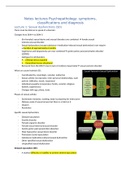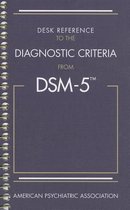Notes lectures Psychopathology; symptoms,
classifications and diagnosis
Lecture 1: Sexual dysfunctions (SD)
There must be distress to speak of a disorder.
Changes from DSM-4 to DSM-5:
- (for females) sexual desire and arousal disorders are combined female sexual
interest/arousal disorder
- Sexual dysfunctions (except substance-/medication-induced sexual dysfunction) now require
a duration of approximately 6 months
- Vaginismus and dyspareunia are now combined genito-pelvic pain/penetration disorder
(GPPPD)
- Subtypes for all disorders
Lifelong versus acquired
Generalized versus situational
- Removed from the DSM-5 due to lack of evidence based data sexual aversion disorder
What can cause/maintain SD;
- Coordinated by; neurologic, vascular, endocrine
- Sexual activity incorporates; inter-personal relationships, each
partner (attitudes, needs, responses)
- Individual sexuality incorporates; family, societal, religious
(beliefs, experiences)
- Changes with age, phase, state
Phases of sexual activity;
- Excitement; fantasies, wanting, body is preparing for intercourse
- Plateau; peak of sexual arouse but there is a hold on it
- Orgasm
- Resolution
Specific sexual dysfunction;
- Delayed ejaculation
- Erectile disorder
- Female orgasmic disorder
- Female sexual interest/arousal disorder
- Genito-pelvic pain/penetration disorders
- Male hypoactive sexual desire disorder
- Premature (early) ejaculation
- Substance/medication-induced sexual dysfunction
- Other specified sexual dysfunction
- Unspecified sexual dysfunction
Delayed ejaculation (DE):
- A marked difficulty or inability to achieve desired ejaculation
, - More common in men over 50 (visual versus tactile)
- Only 75% of men report always ejaculating during sexual activity
- Many theories regarding the aetiology of DE but with little empirical data to support any
particular theory
Three common factors associated with DE:
- Higher frequency of masturbation
- Idiosyncratic masturbatory style
- Disparity between the reality of sex with his partner compared to his preferred sexual
fantasy during masturbation
DE is often mistakenly diagnosed as ED (erectile disorder)
Erectile disorder (ED):
- Failure to obtain or maintain erection during partnered sexual activities
Marked decrease in erectile rigidity
More common in men over 50
- Most problems remit without professional intervention
Medication and relational drugs with a negative impact on erectile function (e.g. antihypertensives,
antidepressants, recreational substances)
Male hypoactive sexual desire disorder:
- Persistent deficient or absent sexual thoughts, fantasies or desires
- 6% of younger 18-24 and 41% of older men 66-74 report problems with sexual desire;
persistent problem in only 1.8% of men
- Many men are often treated for different sexual diagnosis while they are suffering from
HSDD
Sexual desire and sexual arousal are overlapping constructs since both depend on the ability of an
individual to process sexual information during sexual activity.
Erection and satisfaction are different things.
Premature early ejaculation:
- Persistent or recurrent pattern of ejaculation during
partnered sexual activity within 1 minute following
penetration or before individual wishes it.
- 20-30% of men report concern about ejaculation
speed: 1-3% have persistent problem.
Female orgasmic disorder (FOD):
Delay, infrequency or absence of orgasm or reduced
intensity of orgasm sensation
- Wide estimates of prevalence: 10-42%
- 10% of women do not report experience of orgasm
- ‘have you ever experienced orgasm’ – question is key
Risk factors (including major medical causes)
,Likelihood of not having orgasm problems related to;
- Manual genital caressing
- Self-use of vibrator
- Perception that sex is important
- Early age of first orgasm
- Cunnilingus
- Orgasm by penile motion
Risk factors for FOD: abuse, partner with PE, poor communication
Direct masturbation;
- 80% efficacy to obtain orgasm during masturbation in lifelong pre/anorgasmic women
- 20-60% efficacy to obtain orgasm during partnered sexual activity
- Directed masturbation is about learning how to stimulate yourself. Body awareness
- Psycho-sexual treatment
Female sexual interest/arousal disorder (FSAD):
Absent/reduced interest/arousal related to sexual activities, thought, cues, etc.
- Persistent problem for relationships (but this is a hard one to delineate)
What is clinically FSAD:
- Lack of genital arousal/response, lubrication, tingling, warmth
- Lack of body sensations in the rest of the body (subjective arousal)
Risk factors: psychological (inter- and intrapersonal);
- Sexual abuse and traumatic experiences
- Acute/chronic stress
- Self-focused attention
- Anxiety (emotion dysregulation, avoidance tendencies)
- Partners sexual problem
- Relationship problems
- Lack of sufficient stimulation/lack of intimacy
- Lack of privacy
- Cultural aspects
- Life time events as divorce, small children at home
- Medical risk factors
Genito-pelvic pain/penetration disorder (GPPPD):
Difficulties with;
- A vaginal penetration during intercourse
- Pain during intercourse
- Fear or anxiety about pain or penetration, or contraction of pelvic floor muscles during sex
15% of women report some pain during intercourse.
Hypersexual disorder proposed diagnosis; over a period of at least six months, recurrent and intense
sexual fantasies, sexual urges and sexual behavior in association with four or more of the following:
, 1. Excessive time is consumed; by sexual fantasies and urges and by planning or and engaging in
sexual behavior
2. Repetitively engaging in sexual fantasies, urges and behavior in response to dysphoric mood
states (anxiety, depression, boredom, irritability)
3. Repetitive but unsuccessful efforts to control or significantly reduce these sexual fantasies,
urges and behavior
4. Repetitively engaging in sexual behavior while disregarding the risk for physical or emotional
harm to self or others
Sexual dysfunctions:
- 10 diagnostic labels
- 7 have same time criteria
- 2 clusters of symptoms not fitting in the drawer
- 9 labels are a mosaic of the symptoms
When you know which criteria are missing other specified sexual dysfunction
When you don’t know which criteria are missing unspecified sexual dysfunction
Fundamental treatment;
- Basic interventions; these interventions do not apply to each case but are basic interventions
that can be used depending and following thorough BIO-PSYCHO-SOCIAL assessment
- PLISSIT model: permission, limited info, specific info, intensive therapy)
Communication:
- Why is it hard to talk about sex
- Think
- People sometimes lack the specific language
- Use of I statements instead of specking abstractly
- What are they really hearing, saying and meaning
Sensate focus:
- One partner gives while the other receive and
gives feedback
- Initially, no sexual touching gradually build up to
touching genitals, orgasm and intercourse
- Gradual reawakening of sexual interest with no
performance anxiety to increase awareness and
appreciation of the sexual stimulus
- Is usually done with couples but can also be done
with solo-masturbation
Lecture 2: Eating and feeding disorders
DSM-5 feeding- and eating disorders;
- Pica
- Rumination disorder
- Avoidant- restrictive food intake disorder





